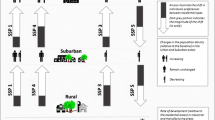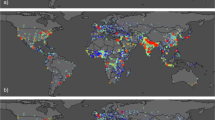Abstract
The objective of this paper was to project the population of the Montreal Metropolitan Community’s municipalities over the 2006–2031 period and assess the effects of changes to urban planning on the expected spatial distribution of the population. For this purpose, we develop a microsimulation model that performs small-area population projections at a municipal level. This model, called local demographic simulations, takes into account local contextual variables such as the expected number of new housing units to be built. We then compare the results from three scenarios with different constraints on the planned residential development of municipalities. We show that although urban sprawl cannot be avoided, increasing the development potential of the central area can slow it. Results also suggest that the age structure of the central area is not significantly affected by different mobility patterns.
Résumé
L’objectif de cet article est de projeter la population des municipalités de la Communauté Métropolitaine de Montréal pour la période 2006–2031 et de mesurer l’effet de changements dans les plans de développement urbain sur la distribution future de la population. À cet effet, nous avons développé un modèle de microsimulation qui effectue des projections locales à l’échelle des municipalités. Ce modèle, nommé Local Demographic Simulations (LDS), prend en considération des variables contextuelles locales telles que le nombre de nouveaux logements construits. Nous comparons les résultats de trois scénarios ayant différentes contraintes relatives au développement résidentiel planifié des municipalités. Nous montrons que malgré le fait que l’étalement urbain puisse difficilement être contré, il pourrait être ralenti en augmentant le potentiel de développement des zones centrales. Les résultats suggèrent également que la structure par âge de la ville centre n’est pas affectée par les différentes dynamiques de mobilité.



Similar content being viewed by others
Notes
The MM is the administrative entity of the metropolitan area of Montreal, which is located in the province of Québec in Canada. It counts about 3.6 million inhabitants in 2006 distributed in 82 municipalities. For the purpose of the projection, three municipalities have, however, been aggregated with an adjacent municipality because of their small population size.
County-like political entities.
References
Ballas, D., Clarke, G. P., & Wiemers, E. (2005). Building a dynamic spatial microsimulation model for Ireland. Population, Space and Place, 11(3), 157–172.
Ballas, D., Rossiter, D., Thomas, B., Clarke, G., & Dorling, D. (2005). Geography matters: Simulating the local impacts of national social policies. York: University of Leeds.
Barcelo, M., & Trépanier, M.-O. (1999). Les indicateurs d’étalement urbain et de développement durable en milieu métropolitain. Observatoire métropolitain de la région de Montréal, Cahier 99-06 (p. 51).
Beatley, T. (2000). Green urbanism: Learning from European cities. Washington, DC: Island.
Bergouignan, C. (2012). Prospective démographique localisée: de la diversité des méthodes à l’importance des données de recensement. Cahiers québécois de démographie, 41(2), 341–367.
Bijak, J., Kupiszewska, D., Kupiszewski, M., Saczuk, K., & Kicinger, A. (2007). Population and labour force projections for 27 European countries, 2002-052: Impact of international migration on population ageing. European Journal of Population/Revue européenne de Démographie, 23(1), 1–31.
Birkin, M., & Clarke, M. (1989). The generation of individual and household incomes at the small area level using synthesis. Regional Studies, 23(6), 535–548.
Bollerslev, T., & Wright, J. (2001). High-frequency data, frequency domain inference and volatility forecasting. Review of Economics and Statistics, 83, 596–602.
Brueckner, J. K. (2000). Urban sprawl: Dignosis and remedies. International Regional Science Review, 23(2), 160–171.
Burchell, R. W., Lowenstein, G., Dolphin, W., Galley, C., Downs, C., Seskin, A., & Moore, T. (2002). The costs of sprawl-2000. Washington, DC: National Academy Press.
Cameron, M. P., & Poot, J. (2011). Lessons from stochastic small-area population projections: The case of Waikato subregions in New Zealand. Journal of Population Research, 28(2–3), 245–265.
Chi, G., Zhou, X., & Voss, P. R. (2011). Small-area population forecasting in an urban setting: A spatial regression approach. Journal of Population Research, 28(2–3), 185–201.
Coleman, D. A. (1992). Does Europe need immigrants? Population and work force projections. International Migration Review, 26(2), 413–461.
Coleman, D. A. (2008). The demographic effects of international migration in Europe. Oxford Review of Economic Policy, 24(3), 452–476.
Communauté métropolitaine de Montréal. (2007). Identification des espaces disponibles à l’intérieur de la zone blanche et évaluation du potentiel d’accueil des municipalités de la Communauté métropolitaine de Montréal, volets 1 et 2, Rapport final (pp. 48). Communauté métropolitaine de Montréal.
Daniels, T. (1999). When city and country collide: Managing growth in the metropolitan fringe. Washington, DC: Island.
Dittgen, A. (2008). Pourquoi et comment tenir compte du logement dans les projections de populations locales. Cahiers de démographie locale, 2008, 99–114.
Filion, S. (1993). L’étalement urbain, phénomène en évolution. En Bref, 4(2), 6–7.
Foggin, P., & Manzagol, C. (1998). De la ville à la région urbain. In C. Manzagol & C. Bryant (Eds.), Montréal 2001: Visages et défis d’une métropole. Montreal: Les Presses de l’Université de Montréal.
Foss, W. (2002). Small area population forecasting. Appraisal Journal, 70(2), 163–172.
Glick, P. C. (1947). The family cycle. American Sociological Review, 12(2), 164–174.
Hamilton, C. H., & Perry, J. (1962). A short method for projecting population by age from one decennial census to another. Social Forces, 41(2), 163–170.
Harding, A., Vidyattama, Y., & Tanton, R. (2011). Demographic change and the needs-based planning of government services: Projecting small area populations using spatial microsimulation. Journal of Population Research, 28(2–3), 203–224.
Huard, A.-M., Deshaies, M.-È., & Garand, G. (2010). Bilan de la situation des milieux humides de Laval (p. 7). Laval: Conseil régional de l’environnement de Laval.
Institut de la statistique du Québec. (2009). Perspectives démographiques du Québec et des régions, 2006–2056, Édition 2009. Québec: Institut de la statistique du Québec.
Institut de la statistique du Québec. (2010). Projection de la population des municipalités, 2009–2024. Retrieved from http://www.stat.gouv.qc.ca/donstat/societe/demographie/persp_poplt/index.htm#municipalit%C3%A9s
Isserman, A. M. (1984). Projection, forecast, and plan on the future of population forecasting. Journal of the American Planning Association, 50(2), 208–221.
Jenks, M., Burton, E., & Williams, K. (2003). The compact city: A sustainable urban form?. London: Routledge.
Kanaroglou, P. S., Maoh, H. F., Newbold, B., Scott, D. M., & Paez, A. (2009). A demographic model for small area population projections: An application to the Census Metropolitan Area of Hamilton in Ontario. Canada. Environment and Planning A, 41(4), 964–979.
Karsten, L. (2007). Housing as a way of life: Towards an understanding of middle-class families’ preference for an urban residential location. Housing Studies, 22(1), 83–98.
Kestens, Y., Thériault, M., & Des Rosiers, F. (2007). Choix résidentiels des ménages lors de l’acquisition d’une maison unifamiliale. In M. Thériault & F. Des Rosiers (Eds.), Information géographique et dynamiques urbaines 1. Hermès - Lavoisier.
Keyfitz, N. (1972). On future population. Journal of the American Statistical Association, 67(338), 347–363.
Kim, T.-K., Horner, M. W., & Marans, R. W. (2005). Life cycle and environmental factors in selecting residential and job locations. Housing Studies, 20(3), 457–473.
Landale, N. S., & Guest, A. M. (1985). Constraints, satisfaction and residential mobility: Speare’s model reconsidered. Demography, 22(2), 199–222.
Lee, B. H. Y., & Waddell, P. (2010). Residential mobility and location choice: A nested logit model with sampling of alternatives. Transportation, 37(4), 587–601.
Logan, J. R., Zhang, W., & Alba, R. D. (2002). Immigrant enclaves and ethnic communities in New York and Los Angeles. American Sociological Review, 67(2), 299–322.
Lutz, W. (2009). Toward a systematic, argument-based approach to defining assumptions for population projections. Laxenburg: International Institute for Applied Systems Analysis.
Marois, G. (2008). La migration de remplacement: un exercice méthodologique en rapport aux enjeux démographiques du Québec. Cahiers québécois de démographie, 37(2), 237–261.
Marois, G., & Bélanger, A. (2014a). Microsimulation model projecting small area populations using ecological and contextual variables: An application to the Montreal metropolitan area, 2006–2031. International Journal of Microsimulation, 7(1), 158–193.
Marois, G., & Bélanger, A. (2014b). Déterminants du choix du lieu de résidence dans la banlieue de Montréal: perspective du cycle de vie et ségrégation. Cahiers québécois de démographie, 43(2), 439–468.
McFadden, D. (1974). Conditional logit analysis of qualitative choice behavior. In P. Zarembka (Ed.), Frontiers in econometrics. New York: Academic Press.
McFadden, D. (1978). Modelling the choice of residential location. In A. Karlqvist et al. (Eds.), Spatial interaction theory and planning models. Amsterdam: North-Holland Publishing Company.
Menthonnex, J. (2010). Perspectives démographiques pour le canton de Vaud. Cahiers de démographie locale, 2010, 149–183.
Mincer, J., & Zarnowitz, V. (1969). The evaluation of economic forecasts. In J. Mincer (Ed.), Economic forecasts and expectations. New York: National Bureau of Economic Research.
Montminy, D. (2010). La protection du territoire agricole de la région métropolitaine de recensement (RMR) de Montréal dans un contexte d’étalement urbain (M.Sc.), Université de Montréal, Montréal.
Murdock, S. H., Hamm, R. R., Voss, P. R., Fannin, D., & Pecotte, B. (1991). Evaluating small-area population projections. Journal of the American Planning Association, 57(4), 432–443.
Nechyba, T. J., & Walsh, R. P. (2004). Urban sprawl. The Journal of Economic Perspectives, 18(4), 177–200.
Neuman, M. (2005). The compact city fallacy. Journal of planning education and research, 25(1), 11–26.
Rees, P. (1994). Estimating and projecting the populations of urban communities. Environment and Planning A, 26(11), 1671–1697.
Rees, P., Norman, P., & Brown, D. (2004). A framework for progressively improving small area population estimates. Journal of the Royal Statistical Society: Series A (Statistics in Society), 167(1), 5–36.
Roberts, W. (2001). The way to a city’s heart is through its stomach: Putting food security on the urban planning menu. Toronto: Crackerbarrel Philosophy Series.
Rogers, A., Raquillet, R., & Castro, L. J. (1978). Model migration schedules and their applications. Environment and Planning A, 10(5), 475–502.
Rossi, P. H. (1955). Why families move. Beverly Hills: Sage.
Rouwendal, J., & Meijer, E. (2001). Preferences for housing, jobs, and commuting: A mixed logit analysis. Journal of Regional Science, 41(3), 475–505.
Sabourin, P., & Bélanger, A. (2011). Microsimulation of language use at home in a multilingual region with high immigration. Paper presented at the 3rd General Conference of the International Microsimulation Association, Stockholm, Sweden.
Simpson, L., & Tranmer, M. (2005). Combining sample and census data in small area estimates: Iterative proportional fitting with standard software*. The Professional Geographer, 57(2), 222–234.
South, S. J., & Crowder, K. D. (1997). Residential mobility between cities and suburbs: Race, suburbanization, and back-to-the-city moves. Demography, 34(4), 525–538.
Swanson, D. A., & Pol, L. (2008). Applied demography: Its business and public sector components. In Y. Zeng (Ed.), The encyclopedia of life support systems, demography volume. Oxford: UNESCO-EOLSS Publishers.
Swanson, D. A., Schlottmann, A., & Schmidt, B. (2010). Forecasting the population of census tracts by age and sex: An example of the hamilton-perry method in action. Population Research and Policy Review, 29(1), 47–63.
Tanton, R. (2014). A review of spatial microsimulation methods. International Journal of Microsimulation, 7(1), 4–25.
Umbelino, G. (2012). Simulations of household spatial distribution and intraurban demographic projections supported by geotecnologie (Ph. D. in Demography), Federal University of Minas Gerais, Belo Horizonte, Brazil.
Waddell, P. (2000). A behavioral simulation model for metropolitan policy analysis and planning: Residential location and housing market components of UrbanSim. Environment and Planning B, 27(2), 247–264.
Waddell, P. (2002). UrbanSim: Modeling urban development for land use, transportation, and environmental planning. Journal of the American Planning Association, 68(3), 297–314.
Wilson, T. (2011). A Review of Sub-Regional Population Projection Methods: Queensland Centre for Population Research, School of Geography, Planning and Environmental Management, The University of Queensland.
Æro, T. (2006). Residential choice from a lifestyle perspective. Housing, Theory and Society, 23(2), 109–130.
Author information
Authors and Affiliations
Corresponding author
Rights and permissions
About this article
Cite this article
Marois, G., Bélanger, A. Analyzing the impact of urban planning on population distribution in the Montreal metropolitan area using a small-area microsimulation projection model. Popul Environ 37, 131–156 (2015). https://doi.org/10.1007/s11111-015-0234-7
Published:
Issue Date:
DOI: https://doi.org/10.1007/s11111-015-0234-7






